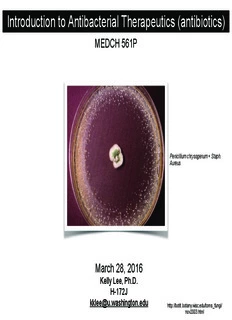
Introduction to Antibacterial Therapeutics PDF
Preview Introduction to Antibacterial Therapeutics
Introduction to Antibacterial Therapeutics (antibiotics) MEDCH 561P Penicillium chrysogenum + Staph. Aureus March 28, 2016 Kelly Lee, Ph.D. H-172J [email protected] http://botit.botany.wisc.edu/toms_fungi/ nov2003.html MedChem561P • Antibacterials: mechanisms of action and resistance • Cell-wall synthesis inhibitors: • Beta-lactams, vancomycin, etc. • Antibiotics for anaerobic infections • Protein synthesis inhibitors: • Macrolides, tetracyclines, aminoglycosides • Sulfa drugs, nitrofurantoin • New antibiotics and combination therapies • Antiviral drugs: influenza, HIV, herpesvirus, HCV • Therapeutic and clinical perspective from Prof. Doug Black: Fridays 12:30-1:30 MedChem561P • Catalyst site where slides, notes, exam keys, etc will be posted: https://catalyst.uw.edu/workspace/kklee/53461/ ! • Course materials including schedule, syllabus, project/paper instructions, general course info can also be found at: http://courses.washington.edu/medch561/NEW/index.html Miracle drugs Can take a potentially fatal condition and CURE an individual Much of modern medical care relies upon the ability to effectively treat microbial infections Surgery Organ transplants Catheterization Joint replacement Cancer treatment AIDS Wounds Birth and delivery Chronic infections Much of modern medical care relies upon the ability to effectively treat microbial infections • For example, hip and knee replacements (~800,000 per year in US): • Antibiotic prophylaxis is commonly used to prevent hospital acquired infections • Currently, infection rates ~0.5-2% • Without antibiotics, the likely postoperative infection rate would be 40-50%, and ~30% of those infections would likely be fatal R. Smith, J. Coast, “The true cost of antimicrobial resistance”, BMJ 2013, vol 346 Impact on health care: big business • In 2004, total global trade in antibiotics > $27 billion • Beta-lactams accounted for ~45% • 6 antibiotics topped $1 billion in sales: • ceftriaxone (beta-lactam) • amoxicillin/clavulanate (beta-lactam+beta-lactamase inhibitor) • azithromycin (macrolide) • clarithromycin (macrolide) • ciprofloxacin (fluoroquinolone) • levafloxacin (fluoroquinolone) Taylor JB and Triggle DJ (eds), Comprehensive Medicinal Chemistry II, vol7! Walsh CT, Antibiotics: Actions, origins, resistance, (2003) ASM Press, Washington DC, USA! Coates A, et al., Nature Rev. Drug Discovery (2002) 1:895-910 Impact on health care • Antibiotics make up a substantial fraction of prescriptions: • ~42% of patients admitted to hospitals receive antibiotics • ~50% of drug prescription costs go to antibiotics, where prescription costs amount to 10-15% of total health care costs ! ! • Places where use is most intense lead to greatest resistance. Most likely place for an individual to acquire an antibiotic-resistant infection is the ICU ! ! • Frequently prescribed unnecessarily. U. Michigan Health System study: In 2002, 41 million antibiotic prescriptions for people suffering from colds (viral), more than one-third of patients who saw a doc about a cold (Feb 24, 2003 edition of Archives of Internal Medicine) The problem we face Incidence of bacterial resistant isolates s c i t o i b i t n a d e v o r p p a - A D F w e N Infectious Disease Society of America 1983-1987 1988-1992 1993-1997 1998-2002 2003-2007 2008-2011 Life in a pre-antimicrobial world Tuberculosis (Mycobacterium tuberculosis) Typhus (Rickettsia prowazekii) Scarlet Fever (Streptococcus pyogenes) Pneumonia (Streptococcus pneumonia, Haemophilus influenzae) Whooping cough (Bordetella pertussis) Cholera (Vibrio cholerae) Diphtheria (Corynebacterium diphtheriae) • Mortality due to infectious disease was ~20x higher in 1900 than now • Before antibiotics Streptococcus pyogenes responsible for ~50% of infant mortality • S. pyogenes also frequently caused death in infected burn wounds • Staphylococcus aureus fatal in nearly 80% of infected wounds • Prior to antibiotics, wound infection killed more soldiers than weapons in warfare
Description: